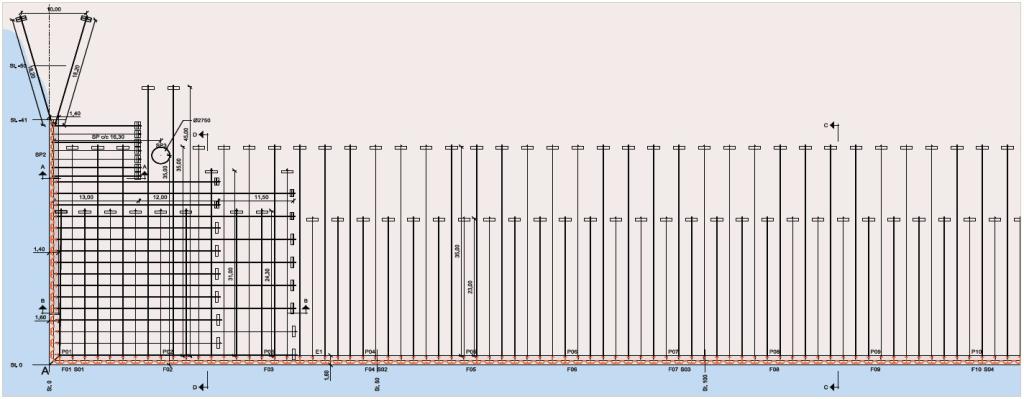
Water Transport Solutions
Extension of Quay
HZ 1080M A-12
HZ 880M A-12
AZ 26-700 infill
AZ 26-700
AZ 28-700
C9, C14
Extension of Port of Ronne - Bornholm, DK | 2019
Download the full case study
The 1 150 m long new breakwater was built first, and the new quay walls, which were inaugurated in October 2019, are Quay 33, a heavy-duty quay, and Quay 34, a multipurpose quay. Both have a dredge line at -11.0 m during the first operation phase, but the final design water depth is -13.0 m. Quay 33 is around 280 m long, whereas Quay 34 is 300 m long and can accommodate cruise ships up to 350 meters. A 60-meter-long Ro-Ro ramp connects the two quay walls.
The solution of the main wall consists of an HZ®/AZ® combined wall system: king piles HZ 1080M A-12 in S 460 AP (mill specification), HZ 880M A-12 in S 430 GP and infill sheet piles AZ 26-700 in S 355 GP. The lengths of the HZ®-M vary from 9.9 m up to 21.8 m and the AZ® infill sheets from 9.1 m up to 17.1 m. Portions of the two return walls were built with AZ 26-700 and AZ 28-700 in S 355 GP and S 430 GP, in shorter lengths (7.9 m to 14.9 m). A total of 2 611 tonnes of steel sheet piles were delivered to Rønne by vessel directly from the rolling mills in Luxembourg.

The design of the quay wall is quite typical for the Danish maritime structures: the main wall is anchored below the water level. However, due to the high anchor loads, the anchor system consisted of two tie-rods, the first at -2.4 m and the second at -3.1 m. The steel rods have a diameter of 63.5 mm and yield strength of 670 MPa. They are fixed to the HZ-M king piles through a special T-connector, and to the discrete concrete panels of the anchor wall with a bolted connection. The concrete anchor panels are placed at variable distance from the headwall, alternating between 23.0 m and 35.0 m (see plan view). A small portion of the quay wall has the anchor connection above water level.
The new project area (150 000 m2) with a total of roughly 550 m of quay has a specific area with a capacity of 500 kN/m2 to load / unload wind turbine parts for the future projects in the Baltic Sea area, including the first project Kriegers Flak with a capacity of 600 megawatts.
The soil is composed of hard sand, followed by hard clay from early Jura period. The backfill was made with approximately 900 000 m3 of sand that was further compacted. The finishing layer of the structure consists of compacted gravel, except along the quay wall border where it is made with a concrete pavement.
Per Aarsleff installed the steel sheet piles and anchors. The HZ-M king piles were installed at a rate of 24 piles a week, with a peak at 8 piles per day, and the AZ infill sheet piles at a rate of 36 double piles a week. It is noteworthy to mention that due to bad weather conditions, the contractor had a downtime of about 40%.
The driving of the AZ sheet piles was performed with a vibratory hammer PVE VM 40 and a free-hanging hydraulic impact hammer IHC S90 (ram weight of 4.5 tonnes) to drive to the final elevation. The HZ-M king piles were driven with a vibratory hammer ICE 1412C and an impact hammer Juntan HHX 160 / HHK 12S (ram weight
of 12.0 tonnes).
The installation took place from a jack-up barge.
The dredging company Rohde Nielsen dredged some 700 000 m3 of material from the bottom of the sea to secure the 11 m water depth.
The first vessel to berth in the new quay was the MV Braemer, a cruise ship, on June 4, 2019.
Total cost of the infrastructure contract: 533 million Danish Krones
(approx. 72 million Euros)





